 |
Formation of Children
Getting the Ball Rolling on Hats
Marian T. Horvat, Ph.D.
Recently I received a letter from a gentleman, Mr. G. F., politely admonishing me for leaving out the chapter in my recently published book, Catholic Manual of Civility, on when a man should remove or tip his hat. He wrote:
“Too many people, especially ‘kids’ have no idea of removing hats (ball caps, hooded sweatshirts) indoors, especially in medical facilities. They even sit through Mass so garbed. Never heard of tipping the hat/removing the hat in the presence of women. Never an idea of tipping/removing the hat when passing a church. And so on. Hats are not much used – at least not in LA! But someone has to get the ball rolling.”
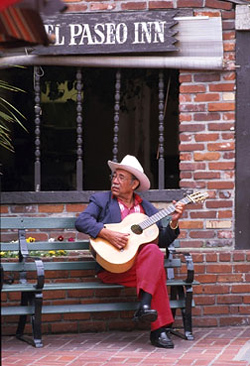
A man in a hat in Olvera Street, the oldest part of Los Angeles |
Mr. G.F. might be pleasantly surprised to find that even in Los Angeles, where I also live, a certain sector of Latinos still regularly wear their sombreros, as he can observe if he goes downtown to one of their favorite places to converse in the square near Old Plaza Church near the famous Olvera Street marketplace.
I should explain that I left those chapters out because in the ‘1940s and ‘1950s - when the manuals I summarized were written – the use of the hat by men represented a whole code of respect and consideration. With the death of the hat, that code disappeared. So, any detailed reference to it would not be practical advice for families aiming to give a good formation to their youth, which was my first goal for the Catholic Manual of Civility.
However, since I have never believed that just because a good custom is set aside, one should give up on restoring it, here I accept the suggestion of Mr. G. F. to “get the ball rolling.” At his request, I will give some essentials on hat etiquette for men. I am also including some picturesque drawings from a 1950s civility manual illustrating the proper way of greeting and addressing others with the hat used in days not so long past.
The dignity of the hat
Until the cultural revolution of the mid-20th century, gentlemen wore hats. Normally a gentleman wore a hat outdoors, not indoors. And if he were a normal well bred man, he knew a passel of rules to follow regarding when to doff the hat and how to do so.
Besides protecting a man against the elements, a hat properly worn gives him dignity. It also permits him to practice a small ceremonial, that is, an act recognizing the right, condition or social status of others.
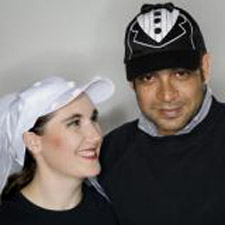
The heighth of extravagent bad taste - bride and groom baseball hats |
Unfortunately, the hat has found a poor replacement today: the ubiquitous baseball cap. In principle, I understand the practical use for this cap in sports. During a baseball game on a hot summer day, it shields the face of the player so he can see the ball in the bright sun. However, the mania of wearing baseball caps all the time and everywhere seems to me as irrational as it would be to wear football or motorcycle helmets all the time and everywhere. There is no practical purpose for such a custom. It is worn because it is in style, a fashion that promotes what is casual and egalitarian. It has become the standard complement to the blue jean, T-shirt and tennis shoes. This ensemble is what an American youth wears in public today, depicting our sadly proletariat mentality and way of being.
The rules of distinction were thrown out the window with the baseball cap. It does not lend itself to protocol. No one lifts the baseball cap to a passing lady. In fact, today the young man may well see a similar cap on the head of the passing lady. It is found today on youth in homes, classrooms, even fine restaurants. Regardless of its other consequences, this is a breach against civility. A civilized man should avoid this mania.
When a man removes his hat
A man should remove his hat upon entering a home, church, office, restaurant or movie theater. There are some exceptions to the “hats off indoors” rule: the hat does not need to be removed in some public buildings (the post office, airport, etc.), on public transportation and at athletic events. A man does not remove his hat in places where he does not seat himself, such as markets, grocery stores or shops. He also should keep his hat on in places through which he is passing, such as the halls and elevators of buildings or standing bars and coffee shops.
However, if and when he seats himself, he takes off his hat. Also, when a well dressed lady enters the elevator, he briefly removes his hat as a compliment to her.
The hat is also removed when the national anthem is played or the U.S. flag passes by in a parade. As a sign of respect, the hat is briefly removed or raised when one passes in front of a Church, an act of homage to Our Lord present in the Blessed Sacrament, or in the presence of a passing funeral procession, in recognition of the deceased as created in the image and likeness of God.
Tipping the hat
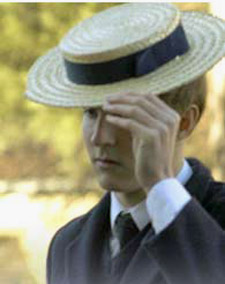
A youth tipping his hat |
To tip one’s hat is to lift it slightly off the forehead either by the brim of a stiff hat or by the crown of a soft one, and then replace it. The modern etiquette books rarely mention the rules that govern tipping or doffing the hat that every gentleman used to know and practice automatically. Almost all men – not just those of the upper classes but of even a modest social level – were quick to correct a son who left his hat on in the presence of a lady with whom he was acquainted. The more cultured knew under what circumstances he should tip his hat even to a stranger, and lift it for friends and acquaintances.
Here are some occasions when a man would lift his hat in public:
- If a lady who is a stranger thanks him for some service or assistance, he lifts his hat in acknowledgement.
- If he asks a woman, authority or elderly man for directions, he lifts his hat as his thanks.
- If he accidentally jostles or disturbs a lady in a crowd or in passing her in a tight space, he lifts his hat and excuses himself, saying “I beg your pardon,”
In short, a man lifts his hat in situations where he would say “Excuse me,” or “Thank you.” It is a polite gesture that “speaks” to the stranger more pertinently than words.
Also, a man always lifts his hat to his wife or any lady he knows when he encounters her, joins her or takes leave of her in public as a sign of his respect.
Removing the hat in a greeting
Upon meeting friends and acquaintances on a walk, during travel, or at a hotel hall or social event, a man lifts his hat, raising it about the palm of a hand, and looks at the person greeted.
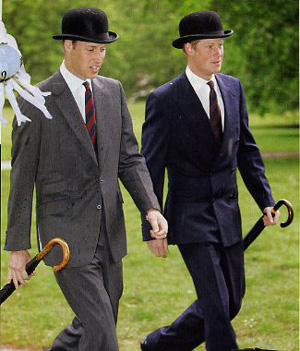
A hat gives dignity to a man. Above, Princes William and Harry heading to a party in 2007. |
A man habitually doffs his hat when he enters into a conversation with a lady or a group of ladies. If the conversation is more than a short greeting, the well bred lady or ladies should invite him after a short while to return his hat to his head. The man also recovers his hat should he continues on his walk either alone or with one of the ladies.
If he meets a superior or a notable dignitary on the street or at an outdoor gathering, he should stop, lift his hat, raise it a small distance from the body with the right arm extended, the bottom of the hat turned toward the ground. The hat should always be held so that the crown faces outwards and the lining towards you. It is considered rude to show the lining, which often reveals sweat, threads of hair or dirt lines.
If the man stops to speak with a superior, after greeting him, he should remain with his feet together and with his hat in his hand until he is invited to cover his head.
It is not wrong for a dignitary or person of higher social statue to initiate the greeting. By this good example, he introduces among the people the customs of deference and mutual respect. It was not rare for heads of families to offer the first salute to those under them, even domestics.
A final note of good advice to the man who takes up the good custom of wearing hats: Keep your hat clean and free from dust, sweat, dirt, and fuzz. The fact that a hat belonged to your grandfather or has a sentimental value does not legitimize the use of a dirty, stained or tattered hat. Far from being considered a gentleman and a man of good taste, the wearer of such a hat makes himself a laughingstock in good society.
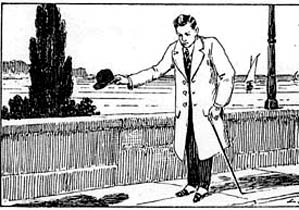
Stopping to greet a superior in the street.The young man stops, his feet together, and with his right hand he removes the hat holding its brim, without showing its interior. He inclines forward slightly, depending on the dignity of the superior he greets. One should take care to maintain an affable gaze and physiognomy. |
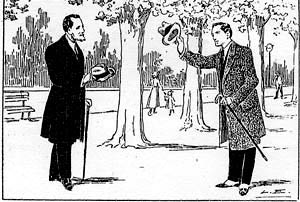
Greeting a superior on a walk, and continuing to walk.
The young man removes his hat some steps away, looks at the person, inclines forward more or less according to his status. He does not show the interior of the hat. After passing, he puts his hat back on.
|
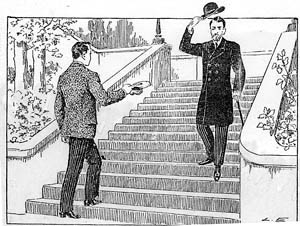
Don’t show the inside of your hat.
The young man correctly leaves the right side of the stair to his superior when the steps are wide enough for both to pass. For narrow stairs, he would stop at the base and allow the superior to pass. However, the youth incorrectly shows the interior of his hat as if he were asking alms. Perhaps for this reason the superior avoids looking at him and seems a bit perplexed. |
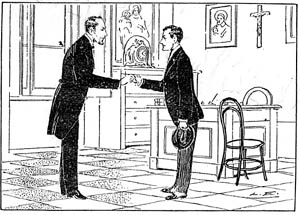
A young man is presented to a superior with a handshake.
Note the attitudes: the young man waits for the superior to offer him his hand and inclines forward respectfully. If they have hats, they are held in the left hand. Usually the superior says some kind words to the man presented or expresses his pleasure to know him, and the latter modestly and amiably thanks
him. |
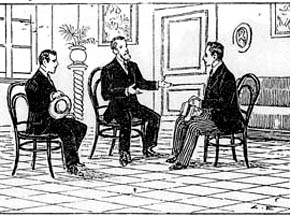
A brief conversation in a living room.
The host did not invite the guests to leave their hats in the hall closet, which means that he expects the conversation to be brief. The host’s gaze is forthright and animated, his gestures natural, his face amiable. The young visitors sit correctly, attentive and respectful. They do not play with their feet, hands or hats, movements which indicate a nervous or uncultured man. |
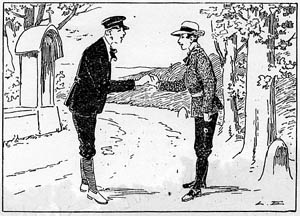
Greeting and handshake between colleagues in the street.
The two men stop, their feet more or less together, and shake hands with vivacity. Between colleagues there is less reserve and more freedom, so it is not necessary to remove the hat. However, care should be taken never to descend into too much familiarity.
|

Posted April 16, 2008

Related Topics of Interest
 The Greeting - Manual of Civility The Greeting - Manual of Civility
 The Blessing - Manual of Civility The Blessing - Manual of Civility
 How to Sit, Stand, Walk How to Sit, Stand, Walk
 The Art of Governing the Hands and Feet The Art of Governing the Hands and Feet
 The Value of Distinction The Value of Distinction
 Dressing Well - Vanity or Virtue? Dressing Well - Vanity or Virtue?
 St. Isidore of Seville on the Importance of Being Dignified in Manner St. Isidore of Seville on the Importance of Being Dignified in Manner
 Four Ways to Discern a Man's Soul by His Appearance Four Ways to Discern a Man's Soul by His Appearance

Related Works of Interest
|
|
Formation | Cultural
| Home
| Books
| CDs
| Search
| Contact Us
| Donate

© 2002- Tradition in Action, Inc. All Rights Reserved
|
 |
|